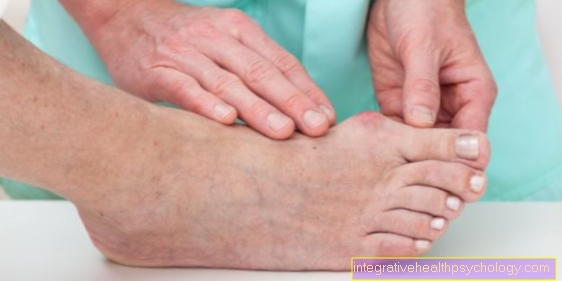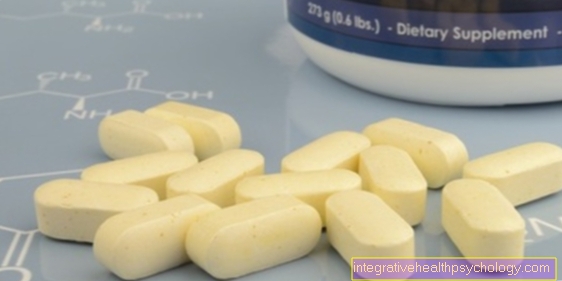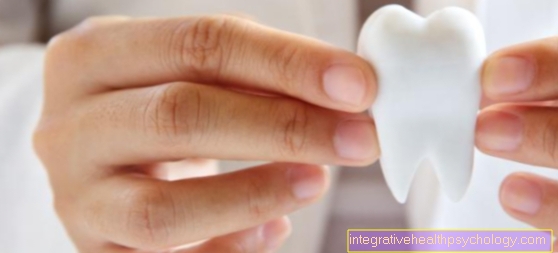Diet shake
What is a diet shake?
Simply put, a diet shake is a drink that is used to reduce body weight. More precisely, diet shakes are often a drink that is used to replace a normal meal of the day. In order to avoid feeling too hungry, they often have a certain macronutrient distribution, which also helps to save calories. In addition, they are packed with lots of micronutrients such as vitamins and trace elements.
You might also be interested in this topic: Formula diet

What diet shakes are there?
Both supermarkets and drugstores, but especially the Internet, now offer a variety of different diet shakes. Whether on a plant or animal basis, the possibilities seem almost inexhaustible. And the price range also ranges from less than one euro per meal for own brands to two or three euros per shake with well-known manufacturers. Some of the shakes are now even offered as a combination to specially designed fitness programs in order to maximize their success.
Diet shakes from DM
The diet shake from DM comes from the house brand "the healthy plus" and is available in two flavors. One can of the powder contains 500g, which corresponds to ten servings. In terms of macronutrient distribution, 100g diet shake powder contains 43g protein, 27g carbohydrates (of which 24g is sugar) and 13g of fat (of which 10.5g of unsaturated fatty acids). In addition, the shake contains lots of trace elements and micronutrients such as potassium, calcium, sodium, zinc, phosphorus, magnesium, copper, etc. The shake also contains vitamins A, D, E, C, B1-12, H.
In terms of protein composition, the shake contains 18 different amino acids, which cover all 9 essential amino acids. The main amino acids are glutamate (glutamic acid) and aspartate (aspartic acid), which roughly corresponds to the situation in the human body. The consumption recommendation for the shake stipulates that the diet should be carried out over a period of three weeks, with three meals being replaced by shakes in the first week and only one meal being replaced by a shake in the last week.
The consumption recommendation on the back is to dissolve 50g of the powder in 200ml of water - preferably to mix with a hand blender to achieve a pleasant consistency. An addition of oil is not necessary with this shake.
Diet shakes from Rossmann
The diet shake from the Rossmann drugstore is called Well-Mix-Shake. One can contains 350g, which, according to the manufacturer, corresponds to 14 servings. This shake is available in various flavors, which allows more variety compared to the DM shake.
The macronutrient distribution of this shake reads as follows:
49g protein, 19g carbohydrates (of which 3g sugar) and 1.5g fat (of which approx. 0.5 is saturated fatty acids). This shake also contains a lot of trace elements and micronutrients such as potassium, calcium, sodium, zinc, phosphorus, magnesium, copper, etc. The shake also contains vitamins A, D, E, K, C, B1-12, H.
A more precise breakdown of the amino acid profile, as is the case with the competing product from DM, is missing on the back of this shake. Unfortunately, no information can be given in this regard. However, it can be assumed that the composition will not differ much from that of the competing products.
Unfortunately, there is no information on the packaging of the shake about the exact sequence of the diet. Only the information that the replacement of two meals with shakes is for weight loss, the replacement of one meal for weight maintenance after the diet can be found in the package. The 25g powder is prepared in 325ml unsweetened soy drink or 300ml low-fat milk (at this point the manufacturer warns against a lower calorie reduction) with 2g vegetable oil.
Almased® Shake
The branded shake from Almased is available in almost every drugstore or can also be obtained from health food stores. Here, too, a pack contains 500g, which, according to the manufacturer, corresponds to ten servings. Here the macronutrient distribution looks like this:
10.3g protein, 6g carbohydrates (including about 6g sugar) and 2.7g fat (including 0.2g saturated fatty acids). As was to be expected, this shake also contains a lot of trace elements and micronutrients such as potassium, calcium, sodium, zinc, phosphorus, magnesium, copper, etc. The shake also contains vitamins A, D, E, C, B1-12, H.However, it can boast of the fact that it counts honey among its ingredients.
Read more on the topic: Almased®
The amino acid profile here includes all 20 proteinogenic amino acids, including the 9 essential ones. Similar to the DM product, glutamate and aspartate are the main components here too. Here, too, there is no more precise information about the course of the diet on the packaging itself. The replacement of two meals a day is recommended. However, there is no indication of the duration. However, it is advertised with positive studies and the uniqueness of the product.
The 50g powder per serving is prepared with 200 ml water, to which six grams of omega-3-rich vegetable oil should be added to round off the fatty acid profile.
You might also be interested in this topic: Diet shake from Doppelherz®
Protein shakes
Protein shakes are especially popular with those on the diet who want to maintain their muscles. Since the body first uses the muscle components - the proteins - for energy production after the carbohydrate stores, shakes offer a good opportunity to supply these components to the body again. In addition, protein shakes have fewer carbohydrates than the usual diet shakes and are therefore even more suitable for a so-called low-carb diet.
Read more on the topic: Low carb diet
As already indicated above, the proteins in the shakes now come from various sources, which can be of both vegetable and animal origin.
In order to lose weight with the help of the protein shakes, however, as with any other diet, the person has to consume fewer calories than they can burn or metabolize. Since sport should be part of every properly executed diet, the proteins or their components - the amino acids - are necessary to maintain the muscles. In addition, certain amino acids have a positive effect on the regeneration of the body.
For more information, see: Protein shakes
Are there lactose-free diet shakes?
Lactose-free diet shakes are no longer uncommon. In recent years, vegan brands have also increasingly established themselves on the dietary supplement market. Compared to the “normal” diet shakes, vegan shakes get their proteins from plant sources such as peas, rice, soy or hemp.
In conventional shakes, however, the so-called whey protein is usually processed. This is a product that consists of milk components and can therefore never be completely free of lactose - the so-called milk sugar. Whey protein is often viewed as a by-product of milk processing. This view cannot quite be maintained. The fact is, however, that the production of whey is much easier and therefore also cheaper.
What is the sequence of a diet with diet shakes?
As already mentioned above, diet shakes should be used to replace normal meals with their help. The principle of this diet is, as with any diet, to consume fewer calories than you burn during the day. However, as the body adjusts itself to having to deal with less energy after a while, weight loss comes to a standstill at some point.
This form of diet now relies on another of the main meals being replaced by a diet shake. The principle behind it is actually self-explanatory. As a result, fewer calories are consumed overall during the day and weight reduction is achieved by the body addressing its stored energy reserves, which ultimately leads to weight reduction.
In principle, this procedure can now be continued until all meals have been replaced by a diet shake. That the weight achieved in this way cannot be maintained as soon as the diet shakes have been replaced by normal meals can also be figured out for yourself.
How much can you lose weight with diet shakes?
In general, care should be taken when dieting that the calorie restriction is not too enormous. Too strong a restriction can spoil the "fun" of a diet right from the start.
Depending on how aggressively you want to approach the diet and how high your starting weight is, several kilos can be lost within the first week. As a rule, a large part of this is water that is held by the carbohydrate stores in the body.
If the carbohydrate stores shrink, the body begins to lose more and more water. However, as the diet progresses, the weight loss decreases. As a rough rule of thumb, you can remember for the weeks after the great loss of water that it may or should be approx. 0.5-1% of your body weight.
Read our next article at this point: Lose weight with NISY
Side effects of the diet
A huge side effect of this type of diet is the directly related “yo-yo effect”. As already mentioned above, the principle of this diet is based on the fact that the amount of calories consumed is continuously reduced. If the diet is now ended and a “normal eating behavior” is assumed, the body has many more calories available than it has been used to in recent times.
You might also be interested in this topic: Lose weight without the yo-yo effect - how does it work?
Unfortunately, the body has adjusted to the reduced energy supply, so that a normal supply of food appears to be an enormous oversupply. The body uses this oversupply to rebuild the fat reserves that have been stubbornly lost in the diet. This fact is still part of the evolutionary survival strategy of our ancestors and unfortunately cannot be circumvented.
Another big side effect is the fatigue and fatigue that occur over time. This is based on the fact that you keep reducing the calorie intake of the body and thus no longer have enough energy reserves available for the day. Even if the diet shakes are mixed with many minerals and micronutrients to prevent malnutrition, this phenomenon cannot be completely ruled out.
Flatulence
Flatulence is a commonly reported problem with diet shakes. However, consumers of protein shakes are also familiar with this problem. The reasons for this can have a wide variety of causes, which is why only the most important are discussed here.
On the one hand, the reason for this could be the increased protein consumption. Diet shakes are usually made up of over 50% of this raw material. Proteins, in turn, consist of amino acids, some of which are difficult to digest and are therefore partly excreted as gases.
Directly based on the protein problem, food intolerance can be brought up in the field. People can have an intolerance to components of the diet powder as well as, for example, to the milk with which the shake is prepared. You can remedy this by preparing the shake with water or a milk substitute.
Last but not least, fiber should be discussed briefly. They ensure that digestion proceeds more slowly and the intestines have more time to absorb the components of the food. If not enough dietary fiber is consumed, an increase in this can lead to an improvement.
Risks of Dieting with Diet Shakes
If you can classify the yo-yo effect as a risk or danger, it should be mentioned here. Other risks include - rarely, but not entirely unlikely - developing an eating disorder. If the disturbed relationship to food in the diet is maintained, this can establish itself as a permanent illness, which in the worst case can end in anorexia of the person concerned.
Of course, there can also be an allergic reaction to a component of the diet shake powder and - if you switch to a diet with shakes over the long term - the occurrence of deficiency symptoms.
How can I avoid the yo-yo effect with this diet?
One way to counteract the yo-yo effect is to harness the horse from behind. Even if it is not recommended, a massive calorie reduction at the beginning, from which one gradually returns to normal eating habits, would counteract a yo-yo effect.
Another possibility could be to include individual so-called cheat days during the course of the diet. They not only maintain the motivation in the diet, but also ensure that the body cannot fully adjust to a reduced calorie intake and still assumes the original calorie requirement as a "principle". Although this behavior also ensures that the diet proceeds more slowly, it is a way of counteracting the yo-yo effect.
Read more on the topic: Lose weight without the yo-yo effect - how does it work?
How high are the costs?
The cost varies with the manufacturer of such diet shake products. To refer to the two branded products from above: A can of Almased or Doppelherz costs around 15 euros. Since such a can contains 10 servings - provided you follow the manufacturer's recommendations for preparation, the price per serving is around € 1.50. In addition, small amounts of a high-quality vegetable oil should be added to the shake powder. If you add this to this, the price per portion increases to a maximum of € 1.60.
The products of the drugstores DM or Rossmann, on the other hand, cost around 7 euros. While the Rossmann container contains 14 servings, DM also only has 10 servings. However, since the Rossmann shake should be prepared with a soy drink instead of water, this results in higher costs that compensate for the additional portions. If you calculate the costs per serving here, the result is around 70-80 cents per serving. Depending on which brand the consumer would otherwise like to fall back on, the costs per meal can be even higher.
What alternatives are there to dieting with diet shakes?
In principle there are innumerable alternatives to this form of diet. The principle of any serious diet is based on the fact that the calories consumed during the day are less than the calorie consumption. This deficit does not have to be reached every day, but can also be calculated on the week, for example. Even if the low-carb trend is currently experiencing a real high, you can also achieve a calorie deficit with a wholesome diet and do not have to do without fats, carbohydrates or proteins.
The idea behind a low carb diet is that you don't give your body any carbohydrates, so the body attacks other forms of energy storage - preferably body fat - to provide energy.
Find out more about the topic: Low carb diet
Evolutionarily, however, we humans are forced to first metabolize our muscle tissue, i.e. the proteins, before the body fat is attacked. To counteract this effect, the muscles must be used to signal the body that it must not break them down because they are still needed. Unfortunately, simple activities such as going for a walk etc. are not sufficient for this. The muscles have to be strained to keep them from breaking down. In the end, however, everyone has to see which type of diet suits them best and which one is easiest to stick to.
Medical evaluation of the diet by Dr.Gumpert.de
On the packaging of these diet shakes there is usually a sentence that indicates that the diet shake should not be a substitute for a balanced diet. In principle, from a medical point of view, that says a lot about it. Such a diet shake is not necessary and the calorie reductions are often too high. For example, Almased recommends replacing two meals with shakes, with each shake only delivering around 250kcal, provided it is prepared according to the recommendation.
In most cases this corresponds to a drastic reduction in calories of more than 500 kcal a day, which is not advisable from a medical point of view. Calorie consumption should be reduced slowly. In addition, from a medical point of view, exercise is an essential part of every successful diet. It ensures that things like blood lipid levels improve significantly faster than a calorie reduction alone.
In addition, it is always crucial for the doctor how long the patient can maintain health-promoting behavior. As a rule, balanced cooking with wholesome products is much more likely to lead people to grapple with issues such as obesity or artherosclerosis than simply replacing meals with shakes without realizing the difference between wholesome and “bad” food.





























